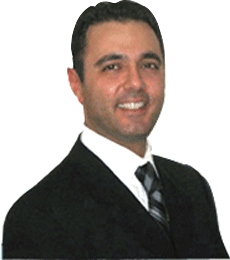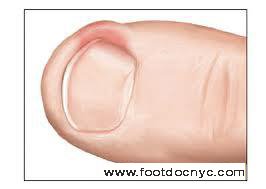Bunion Foot Surgery (Bunionectomy) - General Information, Explanation, Questions & Answers
By Isaac Tabari
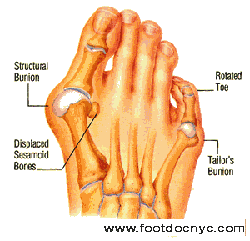
What Is a Bunion?
Before explaining bunion removal surgery, we should first explain what a bunion is. A bunion is a bone at the base of the big toe, also called the metatarsophalangeal (MTP) joint. It forms when the bone or tissue at the big toe joint moves out of place. This forces the toe to bend towards other toes, causing an often painful lump. Bunions are a progressive deformity which means that it worsens over the years producing the characteristic bump that becomes increasingly prominent.
Since this joint carries a lot of the body´s weight while walking, bunions can cause extreme pain if left untreated. The MTP joint itself may become stiff and sore, making wearing of shoes impossible or difficult. Bunions can also occur on the outside of the foot along the little toe. The little toe bunion is called "bunionette" or "tailor´s bunion."
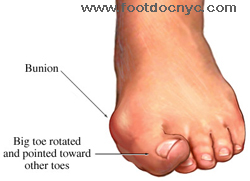
Symptoms
- Swelling
- Development of a firm bump on the outside edge of the foot, at the base of the big toe.
- Pain or soreness
- Inflammation and redness
- Corns or other irritations caused by the overlap of the first and second toes.
- A burning sensation
- Perhaps some numbness
- Restricted motion of the big toe.
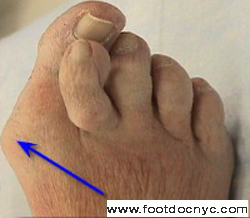
What Causes Bunions?
Bunions form when there is an imbalance in distributing pressure in the foot. This can lead to instability in the joint and cause a deformity. This happens after years of abnormal motion and pressure over the big toe joint. They are, therefore, a symptom of faulty foot mechanics and are ususally caused by the way we walk, and our inherited foot type, our shoes (high heel pumps!), or other sources.
Although bunions tend to be hereditary, it is the foot type that is passed down not the bunion. Parents who suffer from poor foot mechanics can pass their problematic foot type on to their children, who, in turn, are also prone to developing bunions.
Other causes of bunions are foot injuries, neuromuscular disorders, or congenital deformities. People who suffer from flat feet or low arches are also prone to developing these problems, as are patients with arthritis and those with inflammatory joint disease. Occupations that place unusual stress on the feet can also cause this deformity. Ballet dancers, for instance, often develop the condition.
Wearing shoes that cause the toes to be squeezed together is also a common factor, one that explains the high occurrence of the disorder among women.
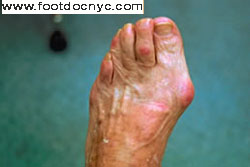
What Can You Do For Relief?
See your New York podiatrist, Dr. Isaac Tabari, or call to make an appointment at (212) 288-3137. Your doctor may apply a non-medicated bunion pad around the bony prominence. He/she may ask you to wear shoes with a wide and deep toe box. If your bunion becomes inflamed and painful, you may need to apply ice packs several times a day to reduce swelling, or avoid high-heeled shoes over two inches tall. See the list below for more detailed conservative treatments. In some cases, a patient may opt for bunion correction surgery.
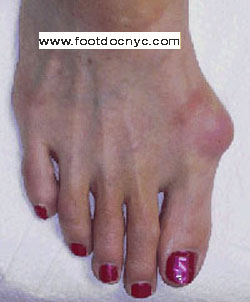
Conservative Non-Surgical Treatment for Bunion Pain
Treatment options vary with the type and severity of each bunion, although identifying the deformity early in its development is important. NYC Foot doctor's medical attention should be sought at the first indication of pain or discomfort because, if left untreated, bunions tend to get larger and more painful, making nonsurgical treatment less of an option.
The primary goal of most early treatment options is to relieve pressure on the bunion and halt the progression of the joint deformity. A podiatrist may recommend the following treatments:
Padding & Taping
Often the first step in a treatment plan, padding the bunion minimizes pain and allows the patient to continue a normal, active life. Taping helps keep the foot in a normal position, thus reducing stress and pain.
Medication
Anti-inflammatory drugs and cortisone injections are often prescribed to ease the acute pain and inflammations caused by joint deformities.
Physical Therapy
Often used to provide relief of the inflammation and from bunion pain. Ultrasound therapy is a popular technique for treating bunions and their associated soft tissue involvement.
Orthotics
Custom shoe inserts may be useful in controlling foot function and may reduce symptoms and prevent worsening of the deformity.
When early treatments fail or the bunion progresses past the threshold for such options, podiatric surgery may become necessary to relieve pressure and repair the toe joint.
Surgical Bunion Correction (Bunionectomy)
A variety of surgical procedures are performed to treat bunions. The procedures are designed to remove the "bump" of bone, correct the changes in the bony structure of the foot, as well as correct soft tissue changes that may also have occurred. The goal of these corrections is the elimination of pain.
In selecting the procedure or combination of procedures for your particular case, your NYC foot surgeon, Dr. Tabari will take into consideration the extent of your deformity based on the x-ray findings, your age, your activity level, and other factors. The length of the recovery period will vary, depending on the procedure or procedures performed.
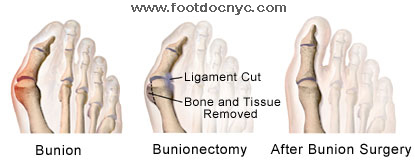
Several surgical procedures are available to the podiatric physician. A simple bunionectomy, in which only the bony prominence is removed, may be used for the less severe deformity. Severe bunions may require a more involved procedure, which includes cutting the bone and realigning the joint.
Recuperation takes time, and swelling and some discomfort are common for several weeks following surgery. Pain, however, is easily managed with medications prescribed by your podiatric physician.
Together with your doctor you can decide if surgery is best for you. Recent advances in surgical techniques have led to a very high success rate in treating bunions.
There are different types of bunion correction surgery depending on the severity of the deformity as well as other factors. Each patient’s foot surgery recovery time varies depending on factors specific to them. For most patients, the first two weeks after surgery require limited weight bearing with little to no pressure to be put on the injured foot, depending on the type of bunion correction. Returning to moderate activity will usually be 2 to 4 weeks after bunion surgery. The key to the fastest recovery and best chance at healing is to listen to your doctor’s orders and follow directions. Most patients will have to wait about 2 to 3 months before returning to a more active lifestyle.
Bunion Correction Surgery - Facts & Myths
There are a lot of myths about a bunion surgery or correction that prevents people from seeking relief for foot pain. Do not let these myths about scare you away. You will soon see that correcting bunions is better than living with the pain and the complications associated with avoiding treatment.
- Bunion surgery is NOT more painful than other surgeries: Any surgery and the recovery period will have pain associated with it. However, bunion surgery is not more painful than other surgeries. Podiatrist will work closely with his patient to provide pain medication and rehabilitation that will minimize your pain.
- Bunion correction DOES NOT require you to miss months of Work: If you have a sitting or desk job, you can return to that work in about a week after the surgery.
- The Bunion DOES NOT grow back after surgery: Although there is a very minimal chance of the bunion growing back, that chance is HIGHLY unlikely.
- After Bunion Surgery you do NOT have to wear Casts and Crutches: Latest advances in treatment and care mean that a cast and crutches are not necessary. Foot doctor may ask you to wear a cam walker. Surgery for larger bunions might require casting, but foot surgeons use latest technologies to limit the casting time..
- Bunion Surgery may be necessary even when there's no pain - IF IT AFFECTS YOUR QUALITY OF LIFE, such as when the bunion gets too large and interferes with activities or wearing shoes.
- Bunion Surgery Leaves an Unsightly Scar: Minimal incisions and alternate types of surgery can leave less of a scar than in years past.
Don’t live with bunion pain. The doctors at NYC Podiatry Center can relieve your pain with state-of-the-art surgical innovations.
***This material is only provided as helpful information and not as medical advice and you should consult with your foot doctor or another medical doctor for a professional diagnosis. ***
For more information on foot and ankle podiatry services and to make an appointment with best NYC bunion surgeon - foot doctor, please call us at (212) 288-3137 or click below to make an appointment:

|






